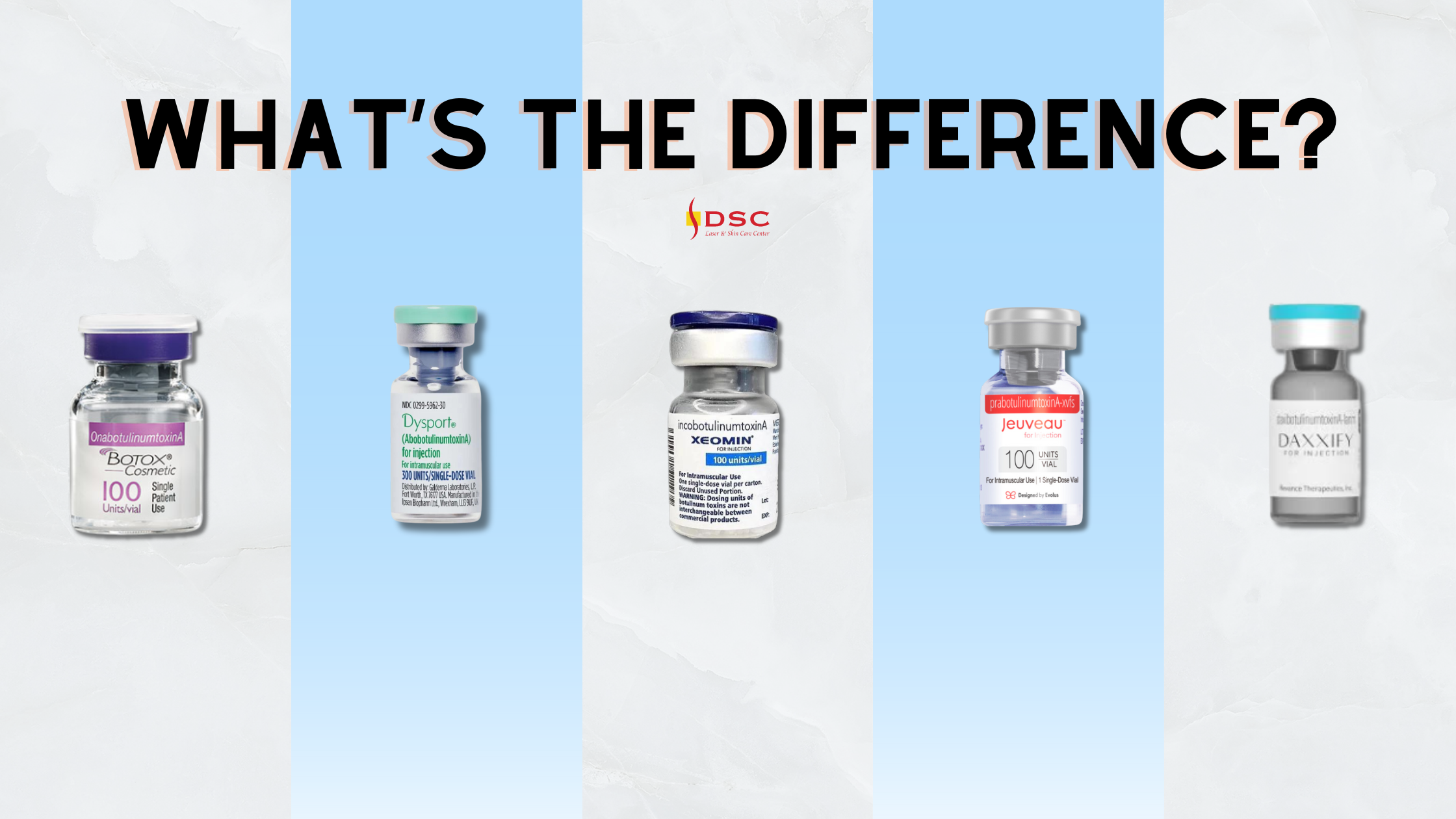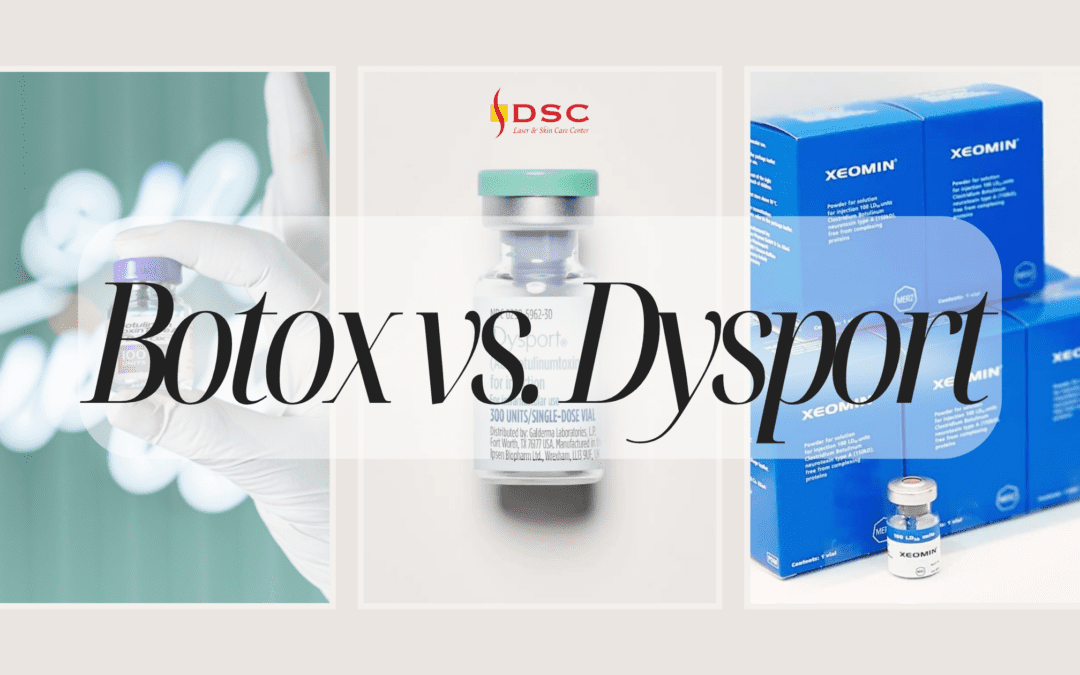Botox versus Dysport – what’s the big difference?
Botox is the number one aesthetic treatment provided worldwide, with almost ubiquitous name recognition. If you don’t know what Botox is, here’s a brief summary: it’s an injectable neurotoxin treatment that temporarily softens wrinkles by paralyzing the facial muscles that cause those wrinkles. It is derived from botulinum toxin, a naturally occurring toxin that is the reason infants can not consume honey under a certain age. For injectable cosmetic treatment, it is synthetically created in the lab under careful supervision.
For an overview on Botox, how it works, and what a treatment is like, read more at our Botox 101 blog post, linked below.
Related: What is Botox?
If you’re no stranger to Botox treatments in the USA, then you may have also heard of other similar treatments, such as Dysport, Xeomin, Jeuveau, and even Daxxify. It’s easy to get mixed up between all these treatments because there are so many different names.
Botox, Dysport, Xeomin, Jeuveau, and Daxxify are the five current brands of injectable neurotoxins approved by the United States FDA for temporary wrinkle improvement. Each brand is released by a different pharmaceutical company and features a slightly different molecular makeup and/or carrier molecule. Functionally, they are all the same – each of these five brands works to temporarily soften wrinkles with the same mechanism. There are actually many more brands available exclusively outside the USA that have not obtained US FDA-approval. You can think of all these brands as different car makers – Makes and models may slightly differ, but all are products that do the same thing.
So, if these five brands of injectable neurotoxins do the same thing, then what’s the difference between all of them? You might be wondering which brand is right for you or which is the best one. Here’s a breakdown on the differences between the five brands currently approved for treatment in the USA.

Botox
Botox is the original, first-to-market injectable wrinkle reduction treatment. Because of this, its name is almost synonymous with the aesthetic injectable treatment. Chances are, even if you don’t quite know what it is, you’ve heard of the name “Botox.” Beyond cosmetic treatment, injectable botulinum toxin has many therapeutic applications, such as treatment for chronic migraines, blepharospasm, spasticity, and cervical dystonia.
Botox is from Allergan Aesthetics and is the trademarked name of onabotulinumtoxinA. Allergan is also the maker of Juvederm fillers. Botox is a combination of a botulinum toxin molecule and human albumen protein. Botox comes in a lyophilized preparation in vials of either 100 units or 50 units. These vials are recognizable by a purple or red vial seal, respectively. Botox is kept in the freezer before reconstitution.
Botox is dosed in “units,” and this form of measurement is the standard by which all brands are measured against. Because the strength of a unit is different across other brands, it is crucial to understand brand-specific dosing when switching between brands. Botox is FDA-approved to treat frown lines, crow’s feet, and forehead lines. FDA approval means that FDA trials were carried out regarding effective treatment in the aforementioned areas. FDA approval dosing is as follows: 20 units to treat the forehead, 20 units to treat the glabella (frown lines or 11’s between eyebrows), and 12 units per side for the crow’s feet. While your individual treatment may vary based on personal anatomy and outcome expectations, this is a general guideline of how many units is needed for a treatment to be extremely effective. Understanding this dosing is important to tempering outcome expectation. If a treated area is not treated with the prescribed units, some muscle movement may still be present. This may be the ideal outcome for those who are new to treatment or still want to retain some natural movement after treatment. For those looking to have absolutely NO movement, treatment in line with FDA-dosing prescription may be necessary. Of course, each individual’s anatomy will account for differences in dosing and injection points.
Botox is indicated to last between 3-4 months. This does not mean that that it is totally gone by time frame, but that natural muscle movement will begin returning around that time frame. Underdosing an area may also account for a treatment not lasting as long, as prescribed effectiveness times are determined with FDA-standard dosing.
Typical treatment effectiveness kicks in around 2 weeks. In the days after treatment, you will notice an area is less and less able to move until full results are achieved after about 2 weeks. It is therefore best to wait for at least this length of time before deciding if you need treatment with more units.
Dysport
Dysport, or abobotulinumtoxinA, is from Galderma Aesthetics, the makers of Restylane fillers and Sculptra. Dysport dosing is unique in that it differs from every other brand. Approximately 2.5 – 3x units of Dysport must be used to get the equivalent effect of Botox, Xeomin, or Jeuveau. For example, 10 units of Botox is about equivalent to 25-30 units of Dysport. Effective treatment of the glabella requires around 50 units of Dysport and 20 units of Botox. Usually this means pricing will differ between Dysport and other brands to account for the unit strength disparity. Dysport generally comes in 300 unit vials, and is recognizable by the green flip off cap. Dysport is stored in the fridge before reconstitution. Dysport also lasts between 3-4 months with on label dosing. Like Botox, Dysport is also FDA-approved to treat frown lines, forehead lines, and the crow’s feet.
While you should still wait about 2 weeks for full results, Dysport tends to start being visibly effective a bit more quickly than Botox does.
Xeomin
Xeomin, or incobotulinumtoxinA, is from Merz Pharmaceuticals, the makers of Radiesse and Belotero dermal fillers. Xeomin comes in 100 unit vials and 50 unit vials and is recognizable by its blue box & blue flip off cap. Xeomin is unique in that it is not bound to a carrier molecule; it is just the purified botulinum neurotoxin. Xeomin is shelf stable and can be stored at room temperature before reconstitution. Like Botox and Dysport, it is also indicated to last between 3-4 months before another treatment is necessary. Unit dosing is similar to Botox. Xeomin is FDA-indicated to treat frown lines (between the eyebrows). Although Xeomin can and does successfully treat forehead lines and crow’s feet, these are technically considered off-label treatment areas because Xeomin has only received FDA approval for treating frown lines.
Jeuveau
Jeuveau, or prabotulinumtoxinA-xvfs, is from Evolus and is FDA-approved for treatment of the glabellar area (the frown lines). This is similar to Xeomin’s on-label, FDA-approved treatment area. Jeuveau is recognizable by its orange-y label and comes in 100 unit vials. Jeuveau shares similar unit dosing to Botox and Xeomin.
Daxxify
Daxxify, or daxibotulinumtoxinA-lanm, is the latest botulinum toxin treatment to get FDA-approval in the United States. Daxxify is from Revance Aesthetics. The selling point of Daxxify is that it is supposed to be effective up to six to nine months. Each of other brands with FDA-approval lasts between 3-4 months, so the advantage of Daxxify is its longevity. Daxxify is also characterized by a peptide carrier molecule, and this peptide is the reason Daxxify lasts much longer than other brands. Daxxify has FDA-approval for treatment of frown lines, like Xeomin and Jeuveau.
So, which is the best brand for you?
This will all depend on you and your specific needs. Your preferred injectable provider may not carry every brand mentioned, so you may be limited to the brands they stock. Brands also tend to vary in price, so it may be more economical to be treated with one over another at a specific provider. There may be promotional deals or rebate programs that may incentivize you to pick one over another. If you’re going for a touch up or another treatment within 3-4 months of a previous treatment, it’s best to stick with the same brand just to prevent any strange side effects. There isn’t any outright danger in switching brands, but based mostly on unit strength differing between brands, which may result in slightly different outcomes. If it’s been more than a few months, it truly does not matter what brand you are treated with; it all comes down to personal preference.
So far, we’ve discussed mostly on-label usage for Botox, Dysport, Xeomin, Jeuveau, and Daxxify. Reducing facial wrinkles is what these treatments are best known for, but there are actually a myriad of other ways and areas these can be used cosmetically. For example, they can be hyper-diluted and injected superficially in a meso-therapy fashion all over the skin to shrink pores and give skin a nice glow. Other areas that can be treated include the masseters, platysma bands, traps, calves, chin, DAO, upper lip, nostrils, and more. Underarms can be treated to reducing sweating. The possibilities are almost endless!
If you are looking to schedule a Botox treatment, Dysport treatment, or Xeomin treatment in Los Angeles, give DSC a call! Our providers are well-trained on the nuances of injectable neurotoxin treatments and can guide you through picking the best treatment for you.
DSC Laser & Skin Care Center
www.dscbeauty.com
(626)285-0800
info@dscbeauty.com
889 S. San Gabriel Blvd. San Gabriel, CA 91776
